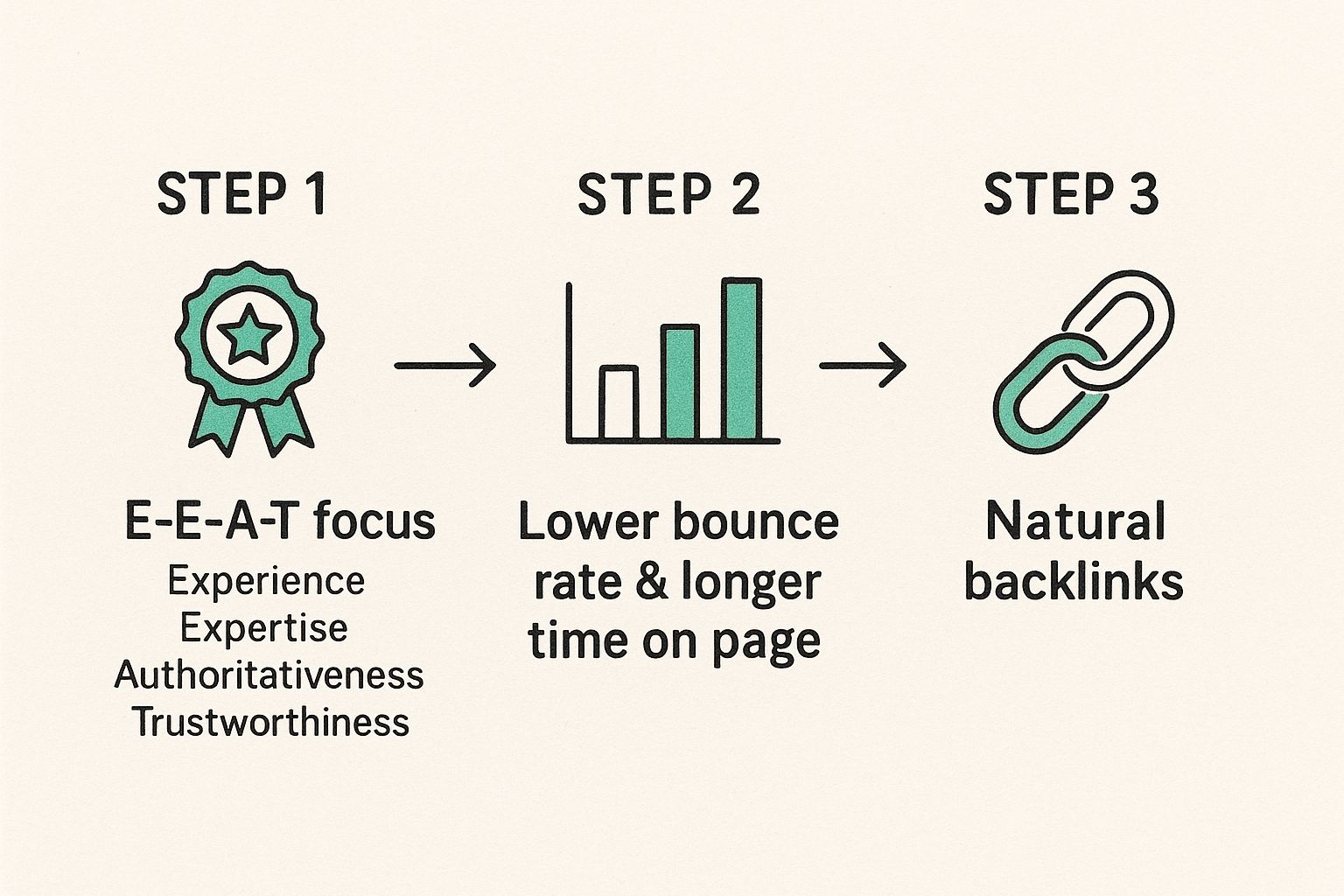How to Humanize AI Text for Free: A Practical Guide for Creators

You can often humanize AI text for free without needing fancy software. The secret is in the manual edit—adding your unique personality and breaking up those predictable AI patterns. It's about moving beyond the tool's default settings by varying sentence length, swapping bland words for more powerful ones, and weaving in your own stories.
The Real Reason Your AI Content Feels Lifeless

Let's be honest—you can spot unedited AI content from a mile away. It often has a flawless but soulless quality, a predictable rhythm that feels manufactured. While AI gives you an incredible head start, it's missing the lived experiences, emotional undertones, and unique quirks that make human writing so compelling.
This isn't a knock against the technology; AI is an amazing assistant. It’s simply a reflection of how it learns. AI models are trained on massive datasets, which naturally pushes them toward common phrases and a safe, neutral tone. The result? Content that is technically perfect but emotionally flat.
The Tell-Tale Signs of AI Writing
AI-generated drafts almost always have a few giveaways that scream "robot." Learning to spot them is the first step to fixing them. Once you know what to look for, you can start editing with a clear purpose: making your content feel genuinely authentic and engaging.
Here are some of the most common patterns we see:
- Repetitive Sentence Structures: AI loves to start sentences the same way ("Additionally," "Furthermore," "In conclusion") or fall back on a simple subject-verb-object rhythm, over and over.
- Overly Formal Vocabulary: Words like "utilize," "leverage," and "instrumental" are dead giveaways. They’re classic AI favorites that can make your writing sound stiff and corporate. For example, an AI might say, "One must utilize this tool," when a human would just say, "You should use this tool."
- Lack of Emotional Depth: An AI can describe an emotion, but it can't feel it. That means it struggles to add the subtle humor, empathy, or passion that truly connects with a reader.
- Generic and Vague Language: Without personal stories or specific examples to pull from, AI content often feels abstract and lacks the concrete details that build trust and authority.
When you can recognize these robotic traits, you stop being just a user of an AI tool and start becoming its editor. You’re no longer just accepting the output; you're actively shaping it to sound like you.
From Robotic to Relatable
The good news? Turning robotic text into something relatable doesn't take a Herculean effort. It just needs a human touch.
To help you get started, it's useful to see the differences side-by-side. This table breaks down the common tells of AI-generated text versus what you should be aiming for with your edits.
AI vs Human Writing Common Differences
| Characteristic | Typical AI Text | Authentic Human Writing |
|---|---|---|
| Pacing | Consistent and predictable sentence lengths. | Varied rhythm with a mix of short, punchy sentences and longer, more descriptive ones. |
| Tone of Voice | Often formal, neutral, or overly optimistic. | Can be conversational, witty, empathetic, or authoritative—it has a distinct personality. |
| Word Choice | Relies on common, safe vocabulary (e.g., "utilize," "ensure," "provide"). | Uses more specific, evocative, and sometimes unconventional words. |
| Personal Touch | Lacks personal anecdotes, opinions, or unique insights. | Includes personal stories, real-world examples, and a clear point of view. |
| Flow | Uses formulaic transitions ("Furthermore," "In addition," "In conclusion"). | Employs natural, seamless transitions that guide the reader smoothly. |
Looking at this, you can see the path forward. For instance, a simple but powerful edit is to replace passive linking verbs with stronger action verbs to inject energy into a flat sentence. If you want to get better at this, we have a guide that breaks down the difference between action verbs and linking verbs.
The demand for tools and techniques to humanize AI content is exploding. One market report by Grand View Research shows just how many creators are facing this challenge.
Here at PureWrite, we believe the goal isn't to "trick" AI detectors. It's to create better, more resonant content ethically. The next sections will give you actionable, free strategies to do just that.
Simple Manual Edits That Make a Huge Difference

Before you start looking for another tool, remember the best one you have: you. Getting your hands dirty with some intentional, manual edits is the fastest way to humanize AI text for free. This isn't about rewriting everything. It's about making small, clever changes that completely change how the text feels.
Think of an AI draft as a perfectly assembled but unseasoned meal. All the ingredients are there, but it’s missing the flavor. Your job is to be the chef who adds the spice—your unique voice, personal stories, and hard-earned perspective. That's what makes the content memorable.
Vary Your Sentence Structure
One of the most obvious AI tells is a monotonous rhythm. AI tends to generate sentences that are all the same length and structure, which can put any reader to sleep. Thankfully, the fix is easy.
Mix it up.
Throw in short, punchy sentences next to longer, more descriptive ones. This creates a natural, conversational pace that keeps people engaged. It’s been shown that content with varied sentence lengths feels more interesting and credible, which is exactly your goal.
- Before (AI-Generated): AI writing tools are useful for content creation. They can generate text quickly. This efficiency helps marketers meet deadlines.
- After (Humanized Edit): AI writing tools are a fantastic starting point. But let's be honest, it’s just a start. By generating text in seconds, they help marketers beat the clock, but the real magic happens when a human steps in.
Inject Your Unique Voice and Stories
AI has never messed up a project, learned a tough lesson, or had a brilliant "aha!" moment. It has no life experiences. That's your secret weapon and the single best way to make your content undeniably human.
Sprinkle in personal stories or real-world examples that only you could know. For instance, if you're a marketer writing about a social media strategy, mention a specific campaign you ran and what you learned. This is how you stop broadcasting information and start building a connection.
The point isn't just to inform; it's to start a conversation. When you share a piece of yourself in your writing, you're inviting the reader to trust the person behind the screen.
Swap Out Robotic Vocabulary
AI loves to use formal, stuffy words to sound intelligent. You know the ones: "utilize," "leverage," "subsequently," and the dreaded "in order to." These words scream "robot" and can make your writing feel cold and distant.
Go on a search-and-destroy mission for these robotic terms. Replace them with simpler, more direct words. For example, "utilize" almost always just means "use." This one small change makes your content instantly more approachable and readable. These swaps are a great first step, but for a deeper look at this, our guide on how to improve English writing skills can help.
Mastering these manual edits is the bedrock of good AI-assisted writing. While tools can add the final polish, these steps ensure your content is authentic at its core. With a bit of practice, you’ll be able to humanize AI text for free without breaking a sweat.
Using Free Tools to Polish Your AI Content

Manual editing is a fantastic starting point, but you don’t have to go it alone. The most effective (and free) workflow involves combining your own touch with a few select tools. This strategy helps you humanize AI text for free by tackling everything from clunky phrasing to readability issues.
The trick is knowing which tool to grab for which job. You wouldn’t use a wrench to hammer a nail, right? The same logic applies here. One tool might be great for simplifying sentences, while another is a pro at catching subtle grammatical quirks.
Start with PureWrite’s Free Features
We built PureWrite to be your first pit stop after you've done your initial manual edits. It’s designed to spot those tell-tale AI patterns and help you adjust the tone and flow without a steep learning curve. Think of it as a specialized checker for authenticity.
Our free version gives you a solid foundation for overhauling an AI draft. You can analyze your text for natural language and see exactly where it falls short. This is about more than just fixing typos; it's about making your content feel like it was written by a person, for a person.
The interface is clean and straightforward by design, so you can focus on your words, not on navigating a complicated dashboard. While the free version gets you started on the right foot, you can see our full suite of features on the PureWrite pricing plans.
Expand Your Free Editing Toolkit
After running your text through PureWrite, a couple of other free tools can add that final layer of polish. Each has its own specialty, and together, they create a surprisingly robust editing process.
Here are two top recommendations for your toolkit:
- Grammarly (Free Version): This is your safety net for grammar, spelling, and punctuation. While AI-generated text is usually correct, it can still be awkward. Grammarly’s free version is great at flagging these basics so you don't miss anything obvious.
- Hemingway App: This tool is wonderfully direct. It ruthlessly highlights long, complicated sentences, passive voice, and weak adverbs—all classic signs of robotic writing. A quick copy-paste into the Hemingway App will instantly show you where to tighten things up for a clearer, more direct voice.
By layering these tools, you create a powerful editing system. PureWrite tackles the specific nuances of AI-generated text, Grammarly handles the grammar fundamentals, and Hemingway ensures your final piece is crisp and easy to read.
Putting together this simple, zero-cost toolkit is one of the best things you can do to produce authentic content consistently. It’s the perfect blend of AI’s speed and the irreplaceable polish that comes from smart tools and your own human judgment.
Why Human-Like Content Is a Powerful SEO Strategy
Using AI to write content is a massive time-saver, but learning how to humanize AI text for free is what really gives you an edge. This isn't about trying to fool an AI detector; it’s about making your content genuinely better and aligning it with what search engines like Google actually want to rank. The smartest SEO play right now is to sound less like a machine and more like an authentic expert.
The days of just stuffing keywords into a page are long gone. Google’s algorithms have gotten incredibly sophisticated, and they're now laser-focused on rewarding content that shows real Experience, Expertise, Authoritativeness, and Trustworthiness (E-E-A-T). Generic AI text often falls flat here because it can't share a personal story or offer a unique point of view.
Boost Engagement and Lower Bounce Rates
Think about your own experience. When you land on a page and the writing is dry, robotic, and repetitive, what do you do? You leave.
But when the content is engaging, conversational, and feels authentic, you stick around. You read more. That’s the power of humanized writing. By adding personal anecdotes, varying your sentence structure, and writing in a natural tone, you’ll see your bounce rates drop and your time on page climb. These are exactly the kinds of user engagement signals that tell Google your content is hitting the mark.
This isn't just theory; it's a clear path to better rankings.

As you can see, focusing on genuine quality creates a ripple effect, building a stronger foundation for your site’s authority over time.
Earn Trust and Natural Backlinks
Let's be honest: nobody links to boring, regurgitated content. The most valuable backlinks—the ones that really move the needle—are earned organically when people find your content genuinely useful.
When your content offers a fresh perspective, shares unique data, or tells a compelling story, other people notice. They cite it, they share it, and they link to it. Standard, unedited AI content rarely inspires this because it's often just a mashup of information that's already out there.
The goal isn't to outsmart an algorithm. It's to connect with a reader. When you focus on genuinely helping your audience, your content naturally becomes what search engines want to promote: helpful, trustworthy information made by people, for people.
This shift toward human-centric content is also big business. According to recent AI text generator market trends, there's a huge demand for tools that add that crucial human touch.
That's exactly where we fit in. At PureWrite, we help you close that gap between a robotic first draft and a polished final piece. Give your AI-generated text a quick polish with PureWrite and see for yourself how much of a difference it makes.
A Practical Workflow for Humanizing AI Drafts
https://www.youtube.com/embed/aCh81GMzwqg
Having the right tools is great, but a repeatable process is what actually saves you time. A solid workflow turns the vague idea of "humanizing text" into a concrete set of steps you can follow every single time. This is how you efficiently and consistently turn that raw AI output into something polished and genuinely human.
The point isn't to create more work. It’s about being smart and applying your effort where it matters most. By following a structured process, you can confidently humanize AI text for free and ensure every piece of content feels authentic.
Starting With the Raw Draft
The moment that AI gives you a first draft, your job begins. Don't think of it as a finished product. Treat it like a very detailed outline or a lump of clay—the basic structure is there, but it has no personality.
Before you change a single word, read the entire thing out loud. This is a game-changer. Your ears will catch the awkward phrasing and robotic rhythm that your eyes just skim over. As you read, make notes on any sections that feel clunky, repetitive, or just plain boring.
The Human-First Editing Pass
This is where you make the content yours. The goal is to inject your voice and perspective by rewriting key sections from scratch. This manual step is the secret sauce for creating content that actually connects with people.
Here’s a simple checklist for your first pass:
- Toss the Intro: Delete the AI's opening and write your own. Start with a sharp hook, a relatable story, or a surprising question.
- Rewrite the Conclusion: Don't just let the AI summarize. End with your own unique takeaway, a call to action, or a question that makes the reader think.
- Fact-Check Everything: AI models can sometimes "hallucinate" or get facts wrong. It's on you to verify every statistic, date, and claim. Your credibility depends on it.
- Inject Personal Stories: Weave in a short, relevant anecdote. Nothing builds trust faster than a real-world example from your own experience.
Leveraging Free Tools for a Final Polish
After you've done the heavy lifting, it's time for the final polish. Free tools can catch the subtle mistakes you might have missed during your manual edit.
We always run our edited text through PureWrite's free tool first to see how it scores for naturalness. Then, popping it into something like the Hemingway App can help simplify any sentences that are still a bit too complex. This one-two punch leaves the content feeling authentic and super easy to read. For more deep dives on writing strategies, the PureWrite blog is packed with useful guides.
This simple system—generate, edit by hand, then polish with tools—creates a fantastic feedback loop. You start to recognize the common quirks of your AI writer and get much faster at fixing them over time.
This isn't just a nice-to-have skill; it's becoming essential. A market report by Grand View Research highlights the explosive growth in this space, showing just how critical it is to master the blend of AI efficiency and human touch. A reliable workflow puts you way ahead of the curve.
Got Questions About Humanizing AI Text? We Have Answers
As you dive into humanizing AI-generated text, you’re bound to have some questions. It’s a new process for a lot of us, mixing incredible technology with the craft of writing. Let's tackle some of the most common questions you might have.
Our goal here is to cut through the noise and give you clear, practical answers. That way, you can get back to what you do best: creating amazing, authentic content.
Are AI Detectors Really 100% Accurate?
Nope, not even close. While AI detection tools are getting smarter, they are far from foolproof.
These tools are built to spot predictable patterns. They look for things like low perplexity (where sentence structures are too similar) and a lack of burstiness (where sentence lengths don't vary much). The problem is, sometimes humans write that way, leading to false positives that flag human writing as AI-generated. A 2023 study from Stanford found that leading detectors incorrectly flagged non-native English writing as AI-generated over 50% of the time.
Your focus should always be on creating high-quality, valuable content that your audience will love. Don't obsess over a "100% human" score. Think of AI detection scores as a helpful pointer, not the final word.
Is Google Going to Penalize My Site for Using AI?
Google has been clear about this: they reward helpful, high-quality content, regardless of how it's created. Using AI by itself won’t get you penalized.
The real danger is using AI to churn out generic, low-effort articles that don't actually help anyone. If your content is just a raw AI dump—with no unique insights or personal touch—it won’t rank well because it fails the E-E-A-T (Experience, Expertise, Authoritativeness, and Trustworthiness) test.
When you take the time to humanize your drafts with personal stories and your own voice, you're actually aligning your content with what Google wants to see. Over time, that can be a big win for your SEO.
At the end of the day, it's simple: write for people, not for search engine bots. When you put the reader first, you’re creating the exact kind of content that search engines are built to promote.
What's the Best Free Way to Make AI Text Sound Human?
Hands down, the single most effective technique is to inject your own voice and experiences into the text. An AI model is just a reflection of its massive, generic training data. It has no idea about that one time a project went sideways or the specific lessons you've learned in your field.
Here’s a practical way to do it:
- Rewrite the Intro and Conclusion: Start fresh here. These are your best chances to make a strong first impression and leave a memorable final thought.
- Weave in Personal Stories: Sprinkle short, relevant anecdotes throughout the article. A quick story about a real-world example instantly shatters the robotic tone and builds trust.
Using these tools ethically is all about keeping your own creativity in the driver's seat. We see AI as a powerful assistant, not a replacement for the human touch. If you're curious about this, you can learn more by reading our guide on the ethical use of AI writing tools.
Ready to turn those robotic drafts into something that truly connects? PureWrite makes it simple. Just paste your text, click a button, and watch it get refined for clarity, tone, and a more human feel.